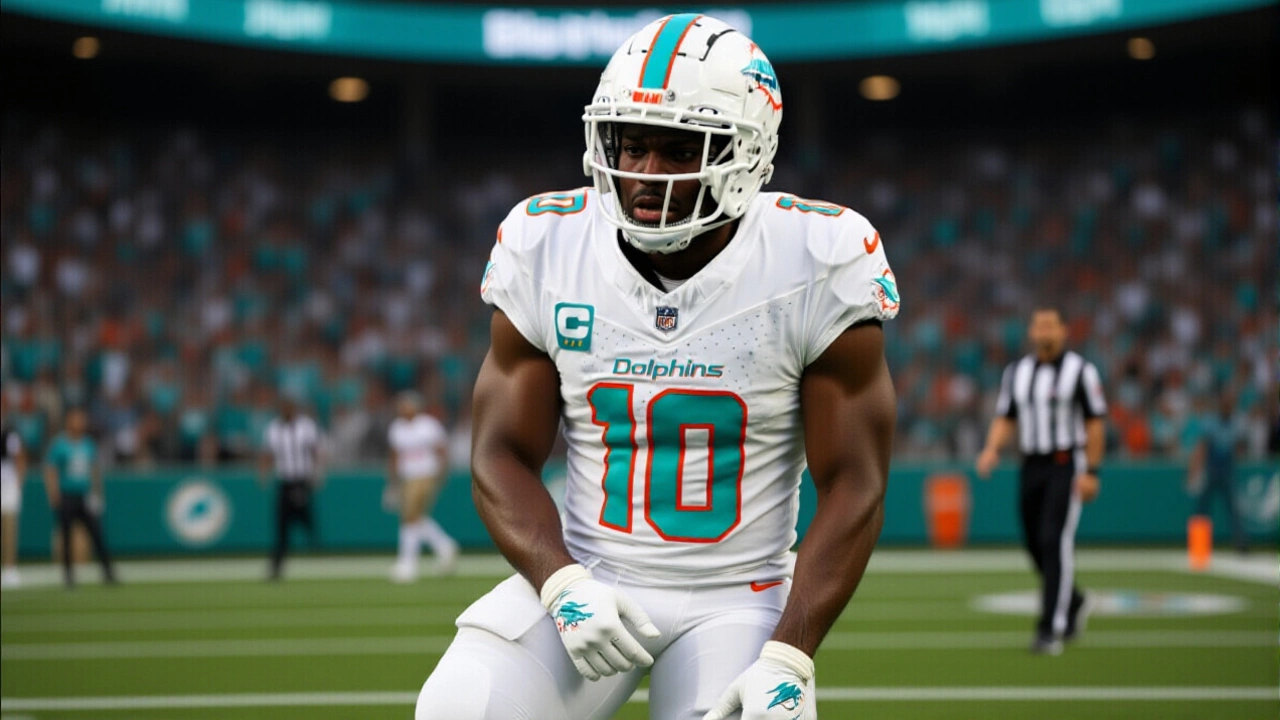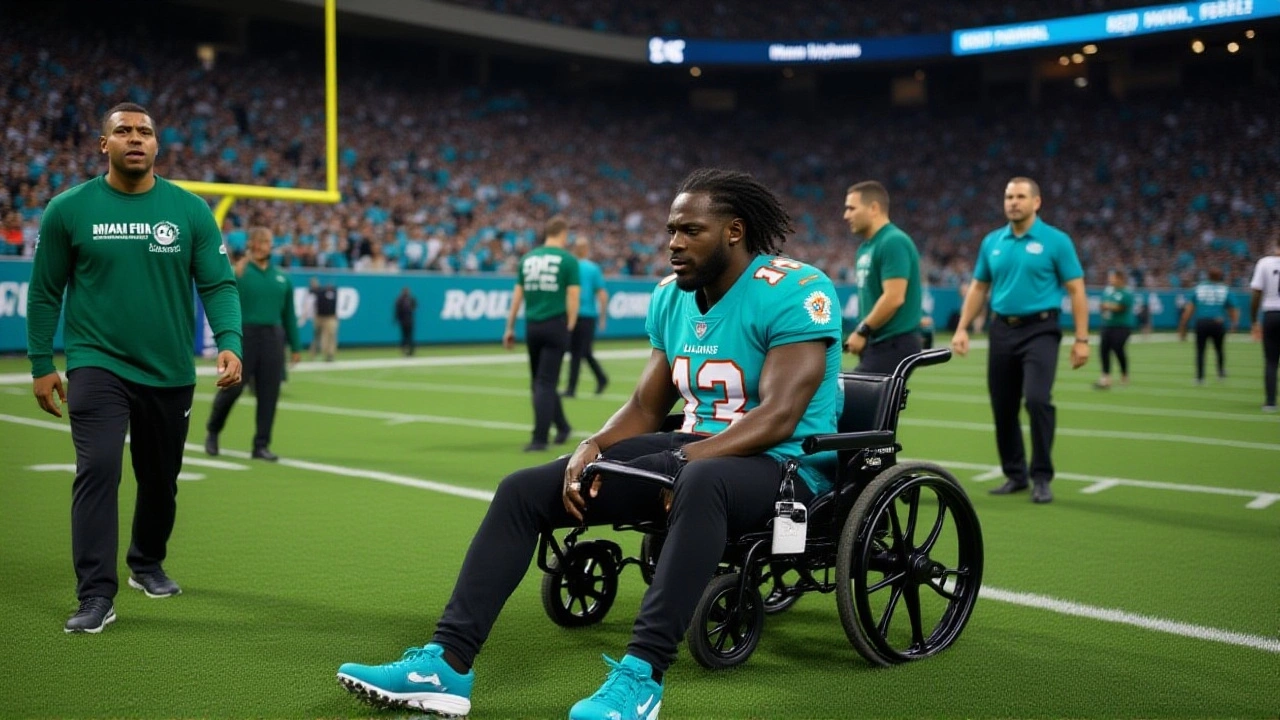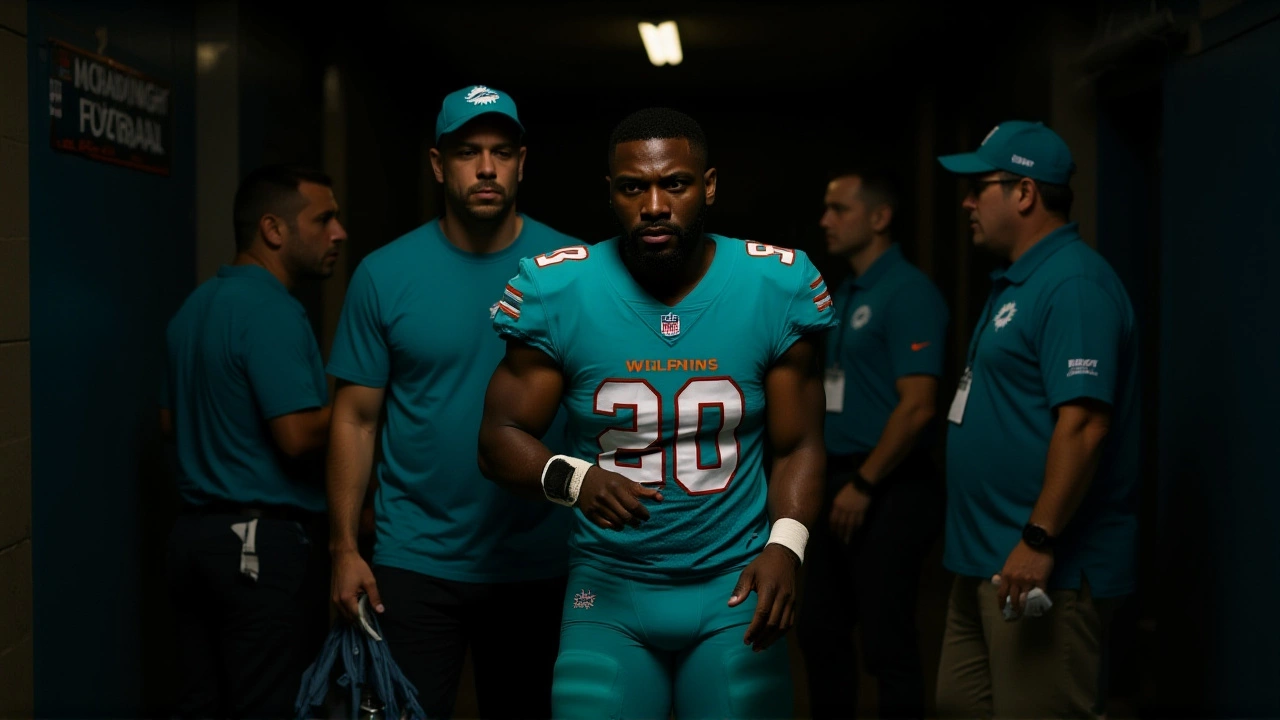When Tyreek Hill, wide receiver for Miami Dolphins was carted off the gridiron at Hard Rock Stadium on Monday night, the stadium’s roar turned into a stunned silence. The 31‑year‑old five‑time All‑Pro had just completed a 15‑yard catch when a defender’s tackle twisted his left knee, prompting an immediate medical response that saw an air cast applied right there on the field. The incident unfolded during a Monday Night Football showdown against the New York JetsMiami, FL, a game that ended with the Dolphins snapping a 0‑3 start to go 1‑3. The why matters: Hill’s speed is a cornerstone of Miami’s offense, and losing him could reshape the team’s passing attack for the rest of the season.
What Happened on the Field
Early in the third quarter, Hill leapt into the end zone to secure a pass from quarterback Tua Tagovailoa. As he turned to step out of bounds, a Jets defender collided with his planted foot, sending a jarring force up his leg. Medical personnel rushed in, and a stretcher‑like cart was rolled onto the turf. While teammates and fans gave a standing ovation, the Dolphins’ coaching staff signaled the seriousness of the situation by removing the ball from play.
Medical Assessment and Immediate Response
According to Adam Schefter of ESPN, Hill was taken to a local hospital for imaging, evaluation, and observation. The next day, Dr. Brian Sutterer, a sports‑medicine specialist, described the injury as a “severe‑looking knee injury,” noting that the MRI showed signs consistent with a potential dislocation. CBS Sports echoed the sentiment, labeling it a “gruesome‑looking knee injury” that could sideline Hill for several weeks, if not longer.
- Injury type: Possible knee dislocation with ligament damage
- Immediate treatment: Air cast applied on‑field, hospital imaging scheduled
- Games missed (estimate): 3‑6 weeks based on similar injuries
- Season stats before injury: 15 receptions, 198 yards, 1 TD
- Team record after game: 1‑3
Impact on Miami’s Season and Offensive Scheme
The Dolphins have built their passing attack around Hill’s explosive speed. In the first three weeks, Hill accounted for 30% of the team’s total receiving yards. Coach Mike McDaniel has a playbook that relies heavily on pre‑snap motion, creating mismatches that Hill exploits with his “jittery stop‑and‑start” ability. Without him, Miami faces a strategic dilemma: either lean more on Jaylen Waddle and De'Von Achane, or diversify the offense with tight ends and running backs.
Indeed, after Hill’s exit, the Dolphins increased multiple‑tight‑end formations to 14% of plays in the second half – a noticeable jump from zero in the first three weeks. Tight end Mike Washington saw a rise in targets, while veteran Darren Waller was asked to run more vertical routes. The shift highlights how a single injury can force a coaching staff to rewrite half of its weekly game plan.

Reactions from Coaches, Teammates, and Analysts
Mike McDaniel, speaking on the Dolphins’ post‑game press conference, said, “Tyreek’s a huge part of what we do. Losing him now is a setback, but we’ve got talent across the roster. We’ll adjust, we’ll stay competitive.”
Quarterback Tua Tagovailoa added, “I’ve seen Tyreek make plays that nobody else can. We’ll keep his spirit alive in the game plan, but I’m also confident in the guys stepping up.”
Veteran receiver Jaylen Waddle, who posted a supportive video on social media, wrote, “Get well soon, brother. We’ve got work to do and I’m ready to pick up the slack.” Analyst Beth Mowins of CBS Sports noted, “Hill’s injury is a ‘big‑picture’ blow for Miami. The Dolphins’ passing efficiency dropped from 7.5 yards per route in the first two games to 5.2 in the Jets game after the injury.”
What This Means for the Rest of 2025
Statistically, teams that lose a top‑5 receiver mid‑season see a 12% decline in scoring output, according to a 2023 NFL analytics report. Miami’s next matchup is against the defending AFC champion Kansas City Chiefs – a test of depth that could determine whether the Dolphins become a surprise playoff contender or slip further down the standings.
If Hill’s rehabilitation goes as expected, he could return by the Week 8 slate, giving Miami a late‑season boost. However, contract considerations loom: Hill’s current deal runs through 2027 with a $12 million base next year, and his health will factor into any future extensions.
Background: The Hill Factor in Miami’s Offense
Since arriving in Miami in 2022, Hill has transformed the Dolphins from a run‑first team to a vertical threat. In 2023, his 1,710 receiving yards ranked fourth league‑wide, while his 0.46 yards‑per‑route after catch (YAC) set a franchise record. His presence forces defenses to allocate a safety to the slot, opening up space for teammate Waddle and running back Achane.
The injury also revives a long‑standing debate about the Dolphins’ reliance on a few high‑octane playmakers versus developing a more balanced attack. Historically, Miami’s 2020‑2022 squads fell flat when key receivers went down, prompting General Manager Chris Grier to double down on depth this off‑season, adding tight ends and versatile backs in the 2025 draft.

Frequently Asked Questions
How does Hill’s injury affect the Dolphins’ passing game?
Hill accounted for roughly 30% of Miami’s passing yards in the first three weeks. Without his speed, the team’s yards‑per‑route is expected to dip from 7.5 to around 5.5, forcing a reliance on deeper routes for Waddle and tighter, short‑area passes for Washington and Waller.
When is Tyreek Hill likely to return?
Medical experts estimate a knee dislocation with ligament damage typically requires 3‑6 weeks of rehab. If Hill’s MRI confirms only moderate ligament sprain, he could be back by Week 8; a more severe tear could push his return to the season’s second half.
Who will step up in Hill’s absence?
Jaylen Waddle is expected to see a 25% increase in targets, while De'Von Achane will likely get more slot routes and jet sweeps. Tight end Mike Washington has already seen a rise in snap count, and veteran Darren Waller could be used in red‑zone scenarios.
What does this injury mean for Miami’s playoff hopes?
The Dolphins sit 1‑3 after Week 4. Missing Hill lowers their offensive ceiling, making a playoff berth an uphill battle. A timely return could keep them in contention for a wild‑card spot, but prolonged absence will likely push them out of the postseason mix.
How does this injury compare to past NFL knee injuries?
Knee dislocations are rarer than ACL tears but often involve multiple ligament damage, leading to longer recoveries. In 2020, Kansas City’s Mecole Hardman missed eight games with a similar injury, while in 2022, New England’s J.J. Watt’s dislocation sidelined him for the remainder of the season. Hill’s age (31) could further extend his rehab timeline.

